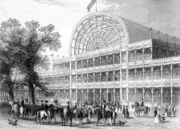
Protector lock
Encyclopedia

Lock (device)
A lock is a mechanical or electronic fastening device that is released by a physical object or secret information , or combination of more than one of these....
design by renowned American locksmith Alfred Charles Hobbs
Alfred Charles Hobbs
Alfred Charles Hobbs was an American locksmith.He was born in Boston, Massachusetts in 1812 and married Charlotte F. and had a child: Alfred J. Hobbs...
, the first man to be able to pick the six-lever
Lever
In physics, a lever is a rigid object that is used with an appropriate fulcrum or pivot point to either multiply the mechanical force that can be applied to another object or resistance force , or multiply the distance and speed at which the opposite end of the rigid object travels.This leverage...
ed Chubb detector lock
Chubb detector lock
A Chubb detector lock is a type of lever tumbler lock with an integral security feature which frustrates unauthorised access attempts and indicates to the lock's owner that it has been interfered with...
at the Crystal Palace Exhibition in the year 1851, which was created with the intent of being a lock that could not be picked.
Before Hobbs and his revolutionary lock designs, locks were opened by making a series of false keys
Key (lock)
A key is an instrument that is used to operate a lock. A typical key consists of two parts: the blade, which slides into the keyway of the lock and distinguishes between different keys, and the bow, which is left protruding so that torque can be applied by the user. The blade is usually intended to...
, in a process that could take extremely long periods of time; if the series was not properly completed in the lock, and the combination not exactly correct, the lock could not be defeated. This design was accepted as quite unbreakable until Hobbs became the first to be able to pick them, by using very fine and careful manual dexterity; applying a certain level of pressure on the bolt
Bolt
-Fasteners:*A cap screw, as used in a bolted joint*Screw, a cylindrical threaded fastener*Dead bolt, a kind of locking mechanism*Bolt , an anchor point used in rock climbing-Weaponry:*Bolt , a mechanism used in firearms...
while manipulating each lever, one at time, using a tiny pick inserted through the keyhole.
In an attempt to create a better locking system, Hobbs proceeded to patent the Protector lock, which, complex in design as it was, involved a transfer in pressure between the lock's internal bolt and tumbler
Tumbler
Tumbler may refer to:* A part of a lock whose position must be changed by a key in order to release the bolt...
mechanisms to a fixed pin. Hobbs claimed that his design was impossible to defeat and superior to the locks that were then in use, but, in 1854, one of Chubb's locksmiths was able to crack it, aided by the use of special tools.
The Protector Lock was distinct from Hobbs's other major lock design of the time, which he called the "American lock", and which slightly preceded the protector lock, in various ways; while the "American lock" was complicated to use, and expensive to purchase, with the added disadvantage of requiring a very big key, it did not differ greatly from the Protector lock so far as the security it offered, and the Protector lock was described as being much simpler to use. The one advantage that the American lock did have over the protector lock was its actual potential for greater security, if certain internal parts of the lock and key were rearranged in a particular way.

